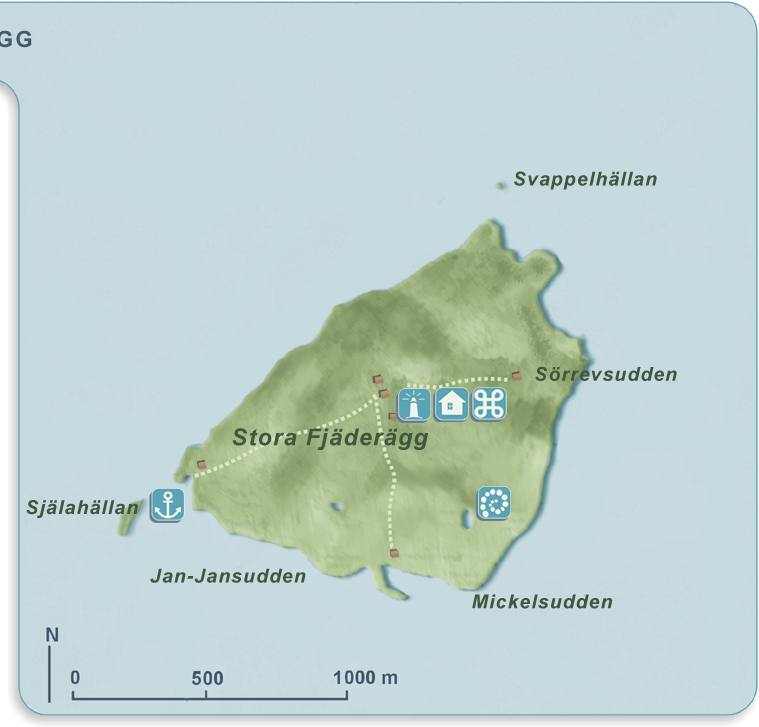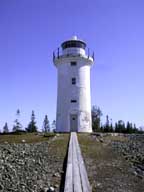Stora Fjäderägg
At Stora Fjäderägg nature and culture meet
- and people meet here as well. The most natural starting point
for outings on the island are the lighthouse-keeper residences
around the lighthouse. A narrow cement walkway leads you from
the harbour, via the sparsely covered boulder-strewn land and
crowberry heaths all the way to the lighthouse. The straight kilometre-long
cement walk is part of Stora Fjäderägg's identity and
this is where you will meet those who are returning to civilization.
You may also be surprised by a cycling ornithologist on his way
to empty his net one last time before the morning's ring marking
session is over.
The "Egg", as birdwatchers usually call the
island, has an exceptional location on the flight path of migratory
birds, where those heading southeast meet the birds heading to
the southwest. Both bluethroats (Luscinia svecica)
with their eye on the Persian Gulf and willow warblers (Phylloscopus
trochilus) on their way to Africa are caught in the fine
mesh of the bird nets. At times the nets are overfull, but they
can also be empty if the winds are not right. The Egg also offers
birdwatchers excellent opportunities to become familiar with sea
birds that migrate far away across the seas. They may be small
groups of loons or flocks of brent geese (Branta
bernicla) heading for the White Sea far to the northeast.
The Egg also provides outstanding opportunities for finding eastern
species of birds that have taken a slight wrong turn and ended
up at this outpost at sea. At least the yellow-browed warbler
(Phylloscopus inornatus) or Pallas's
Warbler (Phylloscopus proregulus) can
rest up for a while on this island before continuing on their
journey.
The birds do not find much protection on the island -
and that is probably just what attracts all the people. Most of
Stora Fjäderägg consists of open heaths with individual
juniper bushes and scattered, dense clumps of spruce trees. But
the island is slowly becoming covered in vegetation since the
cultivation ended and in recent years the birdwatchers and Holmö
residents have actively worked to carefully remove some of the
spruce trees and pines that are starting to take over the heaths.
Stora Fjäderägg is one of the points in Kvarken
that has always been important for navigation in these difficult
waters. In 1850 a lighthouse was built with lighthouse-keeper
homes to secure the traffic coming from the north and heading
for the Kvarken area. At that time several families lived at the
homes, which are close to the lighthouse. Just west of the homes
are the remains of an extremely small field, which shows that
the residents of the island at the time farmed in the hollows
on the barren heaths. The small meadow is now one of the locations
that attracts resting small birds.
Stora Fjäderägg has long been an obvious base
for fish and seal hunting around the northern Holmöarna,
as can be seen in the "gistvallar" - drying racks for
fishing gear - on the south side of the island.
Stora Fjäderägg is a deserted island during
late fall, winter and early spring. In the break between spring
and summer and during the early fall the birding station is staffed.
Otherwise most people come here during the summer. Since 2001
there is a STF youth hostel in the island's light keepers
house. The hostel is managed by Fyrvaktaren HB on behalf of Holmöns
boat museum. Hostel guests are traveling to the island with Holmöslupen,
that makes daily trips between Holmön and Stora Fjäderägg
during summer. The boat belongs to Holmöns boat museum and
is a copy of the type of boat which were common among traders
along the coast of Västerbotten.
If you are considering a visit to Stora Fjäderägg,
remember that you must bring all food with you, preferably even
some spare provisions just in case weather delays your departure
from the island. And don't forget warm clothing. It can be much
colder here than on the mainland, especially in the spring and
early summer.
|









